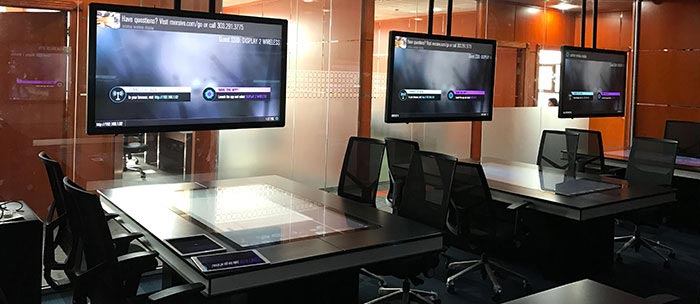
As a new generation of tech savvy, collaborative workers becomes the majority demographic in the workforce, meeting culture is evolving and an important new type of meeting space has emerged – the huddle room. ‘Collaboration’ has quickly become less of a buzzword and more of a way of conducting business, which has driven the rapid build-out of these informal meeting spaces and the need for huddle room technology to supports them.
Collaboration, Productivity, and Office Design
There are many benefits of workplaces becoming more collaborative, but among the most significant and important is that collaborative meeting environments increase user engagement, which has been well-documented to boost both meeting efficiency and productivity. Increased productivity is the holy grail for management teams, and collaboration-based productivity gains are an immense opportunity for businesses that haven’t yet modernized their office design with collaboration spaces and huddle room technology to facilitate short, ad-hoc meetings focused on solving a specific problem or achieving consensus on a particular topic.
Open floor plans and huddle spaces are replacing cubes and traditional conference rooms as the priority for more communal and collaborative spaces grows. While there will always be a need for conference rooms and closed-door meetings, the trend towards open floor plans will likely continue as organizations reap the benefits of their meetings becoming more efficient, engaging, and productive.

Huddle Room Technology
In addition to changing office design, new technology has emerged to support the tectonic shift in meeting culture toward more ad-hoc and collaborative meetings. From traditional star phones to video conferencing, there are countless hardware and software-based solutions fighting to claim their place in these new collaborative meeting spaces. However, one product is already established as a staple in this new type of meeting space.
If you search online for ‘huddle room’ nearly every image result shows collaborators with their laptops and mobile devices sitting around a central display. Huddle rooms are designed to leverage the devices users carry with them, and for this reason nearly every huddle room features a wireless display solution at its center providing BYOD connectivity for collaborators. The ability to seamlessly share what you’re working on from your device for everyone to see and collaborate around is fundamental to the live, ad-hoc use case that the huddle room is built for. The wireless display at the heart of the huddle room provides the platform by which collaborators can easily share project content and related ideas, enabling teams to spend less time passing around a video cable and more time working towards a consensus.
BYOD connectivity is essential to the huddle space, and not all wireless display solutions are created equal. Some key factors for successful collaboration are:
- Ease-of-use for first-time and repeat collaborators
- No artificial limitations on number of connected users and/or amount of content that can be shared
- IT-friendly configuration options since the wireless display will attach to the existing network
As a software-based wireless display solution, Solstice delivers industry-leading capabilities for end users and robust IT security, configuration, and management features. Any number of users can easily connect and share any amount of content to a Solstice wireless display, transforming traditional single-threaded wireless presentation into multi-threaded collaboration. Additionally, the Solstice Dashboard allows technology admins to configure, monitor, and managed all the Solstice displays on the IT network.
Looking Forward
Huddle room technology will continue to evolve as more of these new meeting spaces are built and market requirements change. However, as long as people continue to carry laptops and mobile devices, wireless content sharing to the display will remain central to the huddle room use case. And now with the ability to seamlessly connect and share content across multiple huddle spaces, a new model for content-driven team meetings has emerged to facilitate greater levels of collaboration than ever before. Even individually, though, the huddle room’s ability to catalyze untapped productivity coupled with its relatively low cost means this new type of meeting space is here to stay.